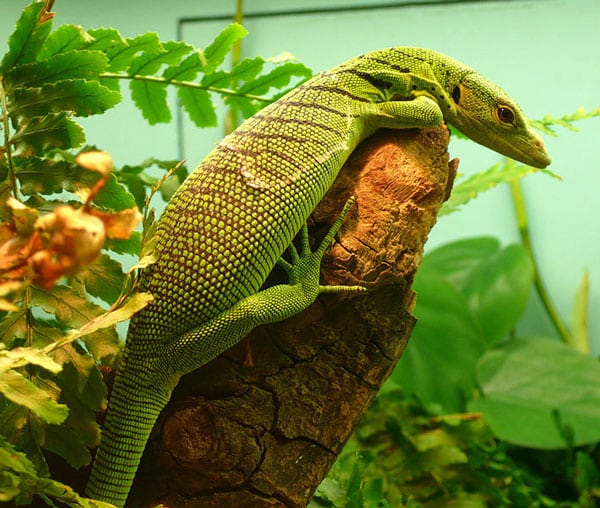Blanding’s turtles are known to be some of the very first turtles out of hibernation. Because they are so cold tolerant, they can be seen emerging and already basking in early March in many regions; however, they may not begin to feed until April.
Photo by Chris Leone Blanding’s turtle. Upon spring emergence, adult male Blanding’s turtles (Emydoidea blandingii) will relentlessly pursue females by chasing them throughout the water and sometimes even on to land. The male’s concave plastron enables him to fit on top of the female’s carapace, where he will grab on tight using his large claws. Mating can last for hours, and during this time, the male will snake his head down in front of the female’s and wave it from side to side. After successful copulation, the pair will separate and move on. Usually by June, on a warm clear evening, the female Blanding’s turtle will leave the water in search of a nesting area. Once a site of appropriate temperature and substrate is selected, she will begin to dig her 4- to 6-inch, flask-shaped nest, using her back feet. Depending on the size and age of the female, six to 16 (and sometimes more) eggs are deposited and then covered with the earth. The turtle will then leave the nest, and the eggs to hatch on their own. Photo by Chris Leone Blanding’s turtle eggs incubating. The Right Temperature to Breed Blanding’s Turtles Blanding’s turtles can be bred by using a few methods, but one thing that remains crucial for most keepers is to provide the adults with a period of hibernation. I leave my adults outdoors year-round to hibernate in their pond, where they are exposed to more natural conditions and a yearly cycle. This time of dormancy stimulates the turtles to breed in the spring and again in early fall. For those who are not in an area that experiences a winter, artificial hibernation can be achieved by using a refrigerator. Turtles can be placed in plastic sweater boxes filled with sphagnum moss and water, and then be put inside the fridge. Here, a constant temperature of about 40 degrees Fahrenheit will keep them inactive until it’s time to pull them out. The turtles should be subjected to a natural temperature decrease, which typically accompanies the change in season. Over the course of six to eight weeks, as you lower the temperatures about 5 degrees each week, they will slow down, cease feeding and continue to bask until the ambient temperature is no longer favorable. In areas where artificial hibernation is a must, the turtles can be brought indoors to a basement or other room, where the temperature drop can be controlled in order to gradually get them ready to hibernate. Dropping it down to 40 too quickly will harm the turtles and may even cause death. Hibernation lasts from late October to late March or early April in the wild. They should be offered a period of the same time length in captivity. When hibernated naturally outdoors, the turtles will wake up on their own and resume normal activities as the weather permits.If artificial hibernation is used, wake the turtles by moving their containers from the refrigerator to a cool room like a basement or garage. After two to three days, place them in their outdoor water source on a relatively cool day. They will then complete the process independently. Avoid releasing them on an abnormally warm day immediately after hibernation; a cooler day supports gradual warming.
After hibernation, breeding season begins. Feed adults hearty meals four to five times weekly to maintain proper weight and support female egg production. Offering whole, skinned mice has proven effective, as they are fully consumed and provide an excellent calcium source. As egg-laying approaches, females may reduce or stop eating and exhibit restless behavior, such as pacing the land area, following fence lines, sniffing the ground, and moving leaves or twigs. This can last up to two weeks, requiring ample land space, typically during evening and night hours. Females often select a nesting site around 6 to 8 p.m., digging extensively before laying the first egg. Once all eggs are laid, allow the female to cover the nest and return to water before carefully excavating and removing the eggs. Incubate them artificially at 86 degrees Fahrenheit, with hatching occurring in 49 to 61 days. Poor fertility in eggs may result from inadequate hibernation or an imbalance in male-to-female ratios. For example, in 2007, only three of 67 eggs were fertile with one male present; adding more males improved outcomes the following year. Causes include males becoming bored with female mates or lacking competition with other males. Note that this species may not lay eggs annually; Blanding’s turtle females, for instance, often lay every other year. Small groups might produce no eggs in a given year, while larger groups may have half the females lay in the first year and the rest in the second. Whether few or many viable eggs result, hatchlings will emerge as miniature adults with large appetites. Keep them indoors in scaled-down adult setups for rapid growth. Sexual maturity is typically reached at 10 years in captivity (20 in the wild), but young males may show breeding and territorial behaviors as early as 5 to 7 years, depending on growth rate and size.The Blanding’s turtle is a remarkable and heart-warming species to work with. Every year, these turtles suffer in their native habitats due to human encroachment and increased predator pressure, leading to poor reproduction rates. Responsible captive breeding and conservation efforts are crucial for their continued existence. Keeping and breeding these rapidly disappearing creatures offers rewards such as doglike personalities, decades of enjoyment, and their comical smiles.
Hatchlings should be fed daily for the first one to two years. Housing multiple hatchlings together usually presents few issues, but tail nips are common as aggressive individuals may mistake others’ tails for prey. To prevent this, provide ample space for escape and ensure they are well-fed. Once sexes can be determined, monitor males closely for aggression and consider relocating them to separate enclosures if necessary. Although not highly aggressive, male Blanding’s turtles should be observed to ensure they do not overly stress other community members. Chris Leone has over 20 years of experience keeping and breeding turtles and tortoises. His work with Blanding’s turtles, Western Hermann’s tortoises, and other species has greatly benefited the global reptile community.


